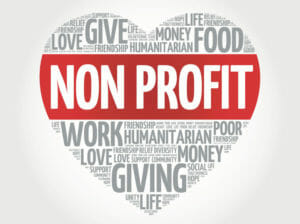
Developing non-profit leaders: World Vision gets down to business
Non-profit growth brings new leadership challenges
The world of non-profit and social change organizations is growing rapidly. Funds being channeled to non-profit organizations have increased dramatically:
- The number of non-profits grew 50 percent faster than businesses over the last 10 years
- Non-profit revenues grew at double US GDP growth rate
- Millennials are an increasingly important demographic group known for prioritizing social change in work and life1
 However, new pressures are also emerging. In addition to more competitors vying for every donor dollar, more is expected from non-profit leaders. The old world of non-profit management was relatively simple. Non-profit leaders focused on keeping “amount spent on overhead” within tolerable ranges for donors. Today there is increasing pressure to allocate resources effectively, create financial sustainability and achieve greater impact.
However, new pressures are also emerging. In addition to more competitors vying for every donor dollar, more is expected from non-profit leaders. The old world of non-profit management was relatively simple. Non-profit leaders focused on keeping “amount spent on overhead” within tolerable ranges for donors. Today there is increasing pressure to allocate resources effectively, create financial sustainability and achieve greater impact.
With growth rates high, a more competitive landscape, and more complex organizations to manage, non-profit leaders need to be developed just like private sector leaders. However, “73 percent of non-profit leaders say they lack resources to build leadership skills.”2
Challenging the status quo of non-profit leadership development
World Vision International, one of the largest international non-governmental organizations (INGO), turned to BTS to develop business acumen in its leaders. Why? There is a growing movement to professionalize the humanitarian industry. In order to meet increasing demands for transparency, accountability and quantifiable impact in the way funds are utilized and how the mission is achieved, World Vision recognized the importance of investing in its leadership capability. World Vision turned to BTS because of BTS’s three decades of experience in creating business acumen solutions for public companies. Together, World Vision and BTS co-created a solution custom fit to the unique challenges of leading in a not-for-profit environment.
World Vision’s challenge is to create leaders that are mission focused, yet business savvy and capable of maximizing every dollar spent. Although a non-profit, World Vision cannot afford to be any less focused on its bottom line than its counterparts in the business world.
An important point to make for the social sector is that the old question of “how much of my dollar is going to the community” is a difficult one for non-profits to answer in a world where costs are rising and competition is increasing. The entire non-profit sector needs to think both about returning greater value to the donor in terms of ROI and switching up the question to, “What value is the community getting for every dollar I am investing?”
World Vision partners with BTS to create a high-impact, custom non-profit business simulation
BTS and World Vision co-created a dynamic business simulation that recreates the World Vision “business model” and allows leaders to deal with difficult decisions, complex trade-offs and demanding stakeholders, all in a safe learning environment. Setting the stage for leaders in the program is critical, so they are invited to the challenge with a pre-read capturing the simulation context:
You and your team will compete with other teams to develop a strategy that will allow your organization to improve the lives of children in need. Engaging in this experience will enable you to practice making critical decisions while managing difficult trade-offs so that you can replicate successful behaviors in your work and ministry.”
The learning experience was designed to impart the following learning objectives:
- Incorporate interdependencies and trade-offs into decision-making processes
- Use leadership and management skills to increase organizational effectiveness
- Identify coaching and development opportunities for staff
- Articulate the implications of global socioeconomic shifts on operational effectiveness
As the teams develop rapport during the program, the intensity is ratcheted up by BTS facilitators. In the midst of dealing with a myriad of trade-offs and making decisions under significant time pressure, the teams run into some surprises. An example of an unexpected event:
Earthquake in Country B:
Last night, an 8.0 magnitude earthquake hit the central coast of Country B, leaving more than 10,000 injured. More than 50,000 homes have been destroyed and violence has broken out throughout the country. In addition, as many as 430 people died when a major religious center collapsed. Officials report that the physical and emotional devastation is extensive. Using the information provided, please discuss the implications of adding more Crisis Relief revenue.
As in real life, the team must come together to address the crisis. They need to take a broad perspective on the organization, while balancing internal and external constraints and keeping a close eye on scarce human and capital resources.
Non-profits deal with the same volatile, uncertain and ambiguous operating environments as for-profit companies. While World Vision leaders will always focus on doing good in the world, they also need business decision-making skills on par with private sector leaders. To sustain the ability to do good for the long term, the organization must be run efficiently and effectively. This means developing leaders who can execute the organization’s strategy while faced with multiple trade-offs across talent, technology, capital budgets and impact goals. How do they balance short-term and long-term requirements? How do they balance the needs of multiple stakeholders and constituents? How do they balance priorities across internal functions to deliver greater outcomes? How do they deliver maximum results for the world’s most vulnerable with limited resources?
World Vision leaders get down to business
In the four years that World Vision and BTS have been partnering in this program, significant shifts have been seen in how leaders think, make decisions and lead their teams across the globe. The program is consistently rated by participants as “the best development I have had in my career” as it pushes leaders to think beyond mere compliance and enables them to envision and achieve what’s possible for a world in need. As leaders focus on a systems approach to delivering measurable outcomes, they learn to align resources to areas of greatest impact. This is done while maintaining the organization’s mission and passion for people and communities.
Year after year, World Vision consistently achieves employee engagement scores in excess of 80 percent across its 45,000 person workforce. Through leadership development focused on the learning and application of business acumen in the World Vision context, leaders are increasing both their ability to measure impact and to impact what they measure: child well-being. Together with the communities they serve, they are making a difference where making a difference matters most.
1Source: The Urban Institute
2Source: Center for Effective Philanthropy and Meyer Foundation
Contact the Authors
Heidi Brandow | Global Practice Leader – Leadership & Executive Development
Dan Parisi | Strategy Alignment& Business Acumen Practice Lead, BTS
- Strategy is like a bag of beads - November 29, 2018
- Customer story: Cultivating culture change at Citizens Bank - August 17, 2018
- Culture change: The magic of transformational moments - May 9, 2018
